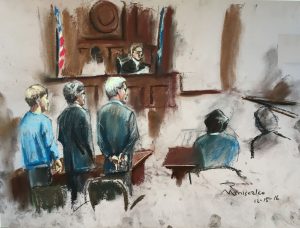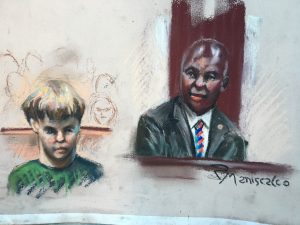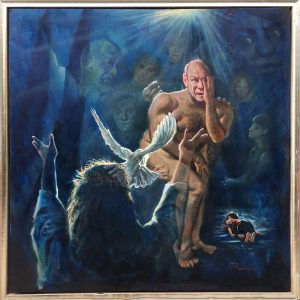Today, on the way to the WCBD News 2 for an interview (below) to plug the closing night conversation around my exhibit, “The Quench Project and the Mire of Desire,” my son asked me if I’d rather be famous or have a lot of money. My answer surprised me.
Turns out the only reason I promote myself and chase notoriety is to earn enough money to provide for my family and to do some good in the world. That’s all I want to do. Use my talents to their fullest, earn enough to provide for my family and have the time and resources to move the dial on the causes for which I advocate.
Truth be told, I hate the constant pressure to perform, to be dynamic, profound, talented. Honestly, I’m fed up with the whole song and dance of trying to “make it.” I just want to be free to create what I want to create, without having to impress or justify myself to anyone. You’ll see why I bring this up if you continue reading.
Last night’s closing Conversation at Fabulon took an unexpected turn near the end of the evening. The conversation around desire, forgiveness and the apathy towards racial inequality was profound and went much deeper than anyone was prepared for. We discussed the person of Dylann Roof, as seen through my sketches, and experienced during first hand encounters by me and one other member of the group in particular, a prison minister named Jackie Morfesis. Inevitably, some debated whether the shooting was “God’s will” or the result of “free will.”

Roof receives his guilty verdict
My sketches were compared to ancient cave paintings because they evoked a similar immediacy and powerful story telling quality, with their “simplicity of statement.” I thought this was very helpful in guiding me where I might go next with my art and appreciated the feedback. As an actor and an artist, I find spontaneous, experiential work, very gratifying. It forms a very important foundation for the way I work, even in my larger, more complex “finished” paintings. So the response was meaningful to me.
Jackie Morfesis took the conversation to an even deeper level when she told the story of how her prison prayer ministry led her to several face to face encounters with Dylann Roof in prison. She described his “serenity” and the easy smile he possessed, something I’d observed while drawing him, especially when the jury was not present. The level of malevolence embodied by this young man, simmering beneath a natural affability, caused a deep disturbance in the fabric of society and unearthed something many in the room referred to as an “imbalance.” To say Charleston has been profoundly knocked off balance by this incident is almost insulting in its understatement. People like Jackie, many of the Emanuel 9 survivors and to some extent myself, are trying to restore this energetic balance by offering themselves as agents of forgiveness in the spiritual warfare being waged every day in Charleston and across the globe. I’ve come to believe the current unrest we are experiencing is far less a political matter than a spiritual battle. Jackie beautifully described forgiveness as an offer to serve, not a condoning of the offense. Forgiveness is not an easy concept to get one’s heart around but it is the only course that can ever truly restore balance.
The question on the table was how did drawing the Dylann Roof trial change my art. I think I got into it pretty deep. What I apparently didn’t realize was this my cue to launch into my life story. But I wasn’t there to present a Ted Talk about how I overcame abuse and oppression. Nor was I there to give my Christian testimony. At one point, I was asked by Susan, the gallery owner, if I might “inspire” those gathered with my personal story. But I was there looking for answers from the people who took the time to show up. I showed up with more questions than answers. Not to lecture, but to explore. I saw my purpose more to honor those assembled by providing a safe forum for deep listening. I t was my understanding that this was going to be about using the work on the walls as a springboard for conversation.
The one thing I forgot in all this, was to ask God to steal the show. I believe that is why things took the turn they eventually did. We got into the issue of forgiveness and racial inequality. Many there were changed by Jackie’s story, which also wasn’t really about her either. I encouraged her beforehand to share her experience because it was about the power of love. It was about how the forces behind Dylann Roof, which were larger than him, just as the power behind forgiveness and redemption are larger than those of us who align ourselves with goodness think it is.
But then something happened. It was near the end of the evening. I was called out for not being as compelling a moderator as I should have been. My story wasn’t moving enough to justify a gallery show, suggested a young man named Christopher. Susan later reinforced his position, suggesting, “it’s not enough for an artist to paint and write about his work. Much more is expected.” Christopher said, “there are a lot of starving artists who don’t get the privilege of showing their art.” It reminded me of a story my father once told me of a lecture he presented at which someone in the audience asked him, “how do you justify your work,” to which he responded simply, “my work justifies itself.”
My artwork and writings justify themselves. If they don’t, then I’ve failed as an artist. I’m okay with my work being judged by its own merits. I’m not okay with me being judged because I’m not a good talker. We have plenty of talkers in the world. We don’t need more.
I wish I’d had the wherewithal to say something along those lines last night. But I simply took the comment to heart; again, I was there to listen. Then the question came up, “what is the difference between illustration and fine art,” as if to suggest my work somehow fell short of fine art. Honestly, this question caught me off guard; it is short hand for the decades old criticism of realistic art, placing nearly all of it in a category along with Norman Rockwell. I know I shouldn’t take this to heart, because it comes out of a deep sickness in the art world, an absurd clash between representational and abstract/Avant Garde artists, which myself and many others have written about extensively.
In addition, I had made a personal point of not proselytizing out of respect to our being guests in a secular venue. But as Jackie pointed out, “your voice was so loud on those walls,” I didn’t feel I needed to. I believe this was about more than a conversation exploring one’s taste in art. It wasn’t even about the machinations of forgiveness. I don’t think there was a person in that room who didn’t see art as an essential vehicle for the revelation of truth, or the importance of understanding and the need to restore balance. And yet, there came a point when everyone was asked to take sides, rather than take a stand for things that truly matter. This was unfortunate.
Maybe I am being overly dramatic but I believe spiritual warfare broke out in that room. Instead of going away inspired by the work on the walls, by the heartfelt sharing of those present, I left feeling attacked by the very people who should have been cheering the project on. Instead, we should have been looking for ways to support this far less than perfect effort to express the voices of redemption, the voices of grace, the voices of forgiveness and reconciliation imbued in the work itself. Could someone more talented and insightful have done a better job with this project. Yes, but they didn’t.

Roof 1-5-17 Gerald Malloy yells, “Look at me,” as Roof Looks straight ahead.
Nor was the evening about “Christians who believe everyone should think like them.” No one ever suggested such a thing, again, out of respect for this being a secular venue. And yet, the comment was made as if it had been. Its important to point out I didn’t feel persecuted in any way as a Christian by this statement. I realize there are many views regarding spiritual matters. And I respect them all. At least I respect peoples’ right to their opinion. But I believe my work as an artist, my value as a creator, was put on trial, in just as real a way as Dylann Roof was put on trial; only I hadn’t killed anyone. I am just trying to make the world a little better with my art. That’s all. I’m certain it was not anyone’s intention to put me on trial. But that’s what happened. As I suggested earlier, I believe forces much larger than any of us were in play.
My desire to be open, available and accepting of other views has gotten me in trouble in the past as well. On one hand it’s a beautiful thing to be that open-hearted, to put one’s self on the display, to be scrutinized; in fact, that’s the job of an artist. But it’s another thing entirely to allow others to completely unmoor me. We cannot do this work unmoored. Perhaps I released my moorings by not praying myself up, which might have availed me of the peace that passes all understanding and could have protected me against the raging sea.
I have seen first hand, the devil is often soft spoken and wears a charming smile, like Dylann Roof. He places the slightest doubt in our minds and let’s our imagination do the rest. That was how the evening ended, unfortunately. As Jackie wrote to me after, “If you don’t wear God’s armor the armies will invade.” And so they did.
So, though we may have lost the battle, the war is still to be won. As one of the honored guests, Darren Lee Calhoun of the Avery Center, pointed out:
“We won’t see the results of the work we are doing now during our lifetime.”




 Would you like to get inspiration in your inbox, rather than ads for more stuff? Welcome to ManiscalcoGallery.com
Would you like to get inspiration in your inbox, rather than ads for more stuff? Welcome to ManiscalcoGallery.com